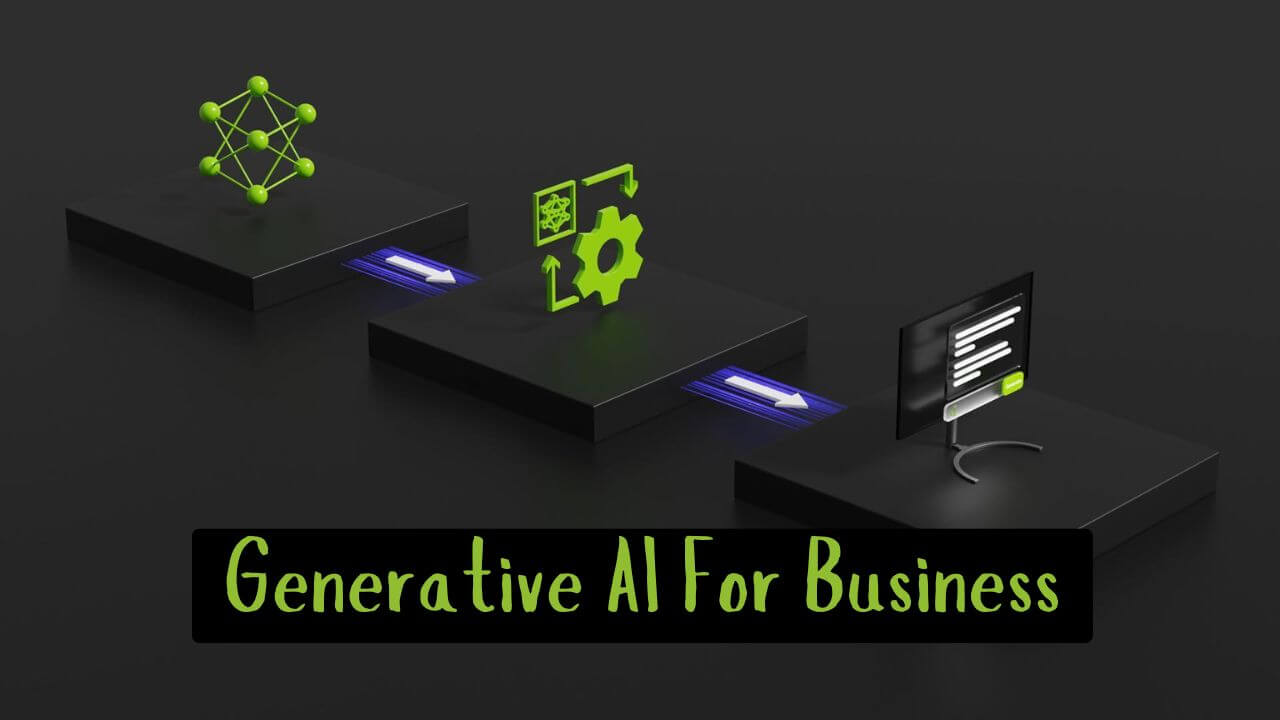Generative AI is already on the horizon as a powerful force that will change the nature of business and alter the way organizations think, operate, and interact with their customers.
Because generative AI is based on complex algorithms and big data it can create texts of high quality, generate ideas, and improve many processes in the company, thus creating a competitive advantage.
All the way from marketing to individual customer approaches, as well as incorporating generative AI into the decision-making process.
When organizations strive to become more effective and survive in a rather dynamic environment, aspiring generative AI comes into the main focus.
From this introduction, the user is envisaged with an understanding of how generative AI is revolutionizing business, its advantages, and the resource stage that is required in order to fully harness this technology towards the achievement of sustainable business development and growth.
Rise Of Generative AI In Business
How AI is Changing Our World: The Journey from Magic to Reality
Arthur C. Clarke once said, “Any sufficiently advanced technology is indistinguishable from magic.”
And let’s be real—if you’ve ever played around with Generative AI, there’s a good chance it felt like magic at first.
Suddenly, you had this piece of technology that could write poems, draw stunning images, even crack a joke or compose music.
And not just any technology—one that understands you, speaks your language and responds with something entirely new. Crazy, right?
But here’s the thing: AI is not magic. It’s math, science, and decades of work that’s finally coming together.
And the truth is, it’s going to touch every corner of our lives. How it change our world, though? That’s up to us—all of us.
Chapter 1: The History of AI – Where Did It All Start?
Let’s rewind a bit.
AI didn’t just pop up overnight. People have been dreaming about machines that could think for well over a century.
But things really got moving in 1950 with Alan Turing, the guy often called the father of AI. His famous paper laid out the possibility that machines could one day play chess, understand language, and—get this—think.
I mean, can you imagine?
Back in the 1950s, thinking machines were pure sci-fi, but Turing saw the future. Fast forward a few decades, and we’ve seen many of his predictions come to life.
Computers beat humans at chess (hello, Deep Blue!), and AI can now debate, write stories, and even help businesses make decisions.
But Turing was just the spark. The real explosion happened in 1956 at what’s called the Dartmouth Workshop.
A small group of super-smart people (think Bell Labs and IBM scientists) got together to officially kick off the field of Artificial Intelligence. It’s where the actual term “AI” was born.
Now, remember, this was 1956. The same year the transistor won the Nobel Prize. Today, we’ve got GPUs with over 100 billion transistors powering the AI we use.
What’s really wild is that for all the progress we’ve made in hardware, the real game-changer for AI has been data—massive amounts of data, combined with clever algorithms.
So, What Exactly is Generative AI? (And What Makes It Special?)
You’ve probably heard of large language models (LLMs), right? They’re the engines behind generative AI—the AI that’s writing poems, creating art, and surprising us in ways we never thought possible.
But how do they work?
Well, at its core, an LLM represents language in a super complex, multi-dimensional space with tons of parameters. Imagine training an AI on a massive collection of text.
It learns patterns in the language, predicts what words come next, and before you know it, it’s generating something totally new.
That’s generative AI in a nutshell—it discovers patterns, predicts relationships, and then creates something that didn’t exist before.
Let’s break it down further:
- Old-school AI was all about specific tasks. It could do one thing really well, but that was it.
- Generative AI, on the other hand, can create. It’s not just following rules—it’s making new things, whether that’s text, images, or sounds.
This isn’t just fancy tech. It’s practical. Think about AI writing code, identifying fraud in banking, or helping customer service teams. That’s the beauty of it.
What’s the Secret Sauce Behind Generative AI?
Alright, here’s the secret sauce: three things make generative AI possible—model architecture, compute power, and data. These three pieces have finally come together in a way that allows AI to do mind-blowing things.
Model Architecture – This is how the AI is built. Think of it as the brain of the system, full of neurons that fire and connect in ways that let it learn and create.
Compute Power – AI needs a lot of muscle to do its thing. We’re talking about billions of transistors working together in GPUs to give it the computing strength it need.
Data – Here’s where it gets really interesting. AI thrives on data. The more it has, the better it gets. Generative AI was trained on tons of internet data to learn natural language and, well, act human.
And here’s something cool: unlike the early days of AI, where humans had to label data manually (which was expensive and slow), we now have something called self-supervised learning.
This allows AI to learn from raw, unlabeled data—things like predicting missing words in a sentence. This process gives AI the ability to understand language in a deeper, broader way.
Foundation Models: The Brains Behind Generative AI
Ever wonder what powers tools like ChatGPT, DALL·E, or Google Bard? It’s these things called Foundation Models.
These are massive neural networks trained on gigantic datasets that can be adapted for a wide range of tasks.
What’s amazing is that foundation models aren’t limited to just language. Anything that can be represented in data—signals from industrial equipment, clicks on a website, even chemical diagrams—can be understood by AI.
And this means one thing: AI can stretch across industries and tasks like never before.
Imagine AI writing software code, analyzing cybersecurity threats, or automating HR tasks. Generative AI isn’t just a tech novelty anymore. It’s becoming a business necessity.
Chapter 2: The Future of AI – What’s Next?
So, where is all of this headed?
We’re in a moment where AI’s possibilities seem endless, but here’s the kicker: today’s AI models still aren’t true general intelligence.
They’re amazing at specific tasks—some can even pass the famous Turing Test—but we’re not talking about AI that can think like humans just yet.
That said, AI is already changing the world in profound ways. It’s touching industries like medicine, climate science, and energy, helping us tackle some of the biggest challenges we face.
But there’s also fear.
Some worry that AI will lead us to a dystopian future where jobs are lost, and privacy is compromised. Others think we’re on the verge of a golden age where AI will solve all our problems.
The truth is somewhere in between. As with any major technological shift, it’s all about how we choose to use it.
How Do We Shape the Future of AI?
This is the important part: the future of AI isn’t set in stone. It’s not up to just a few people or companies to decide how AI evolves. It’s up to all of us.
Here’s what that means for you and your business:
Protect Your Data – Your data is your competitive edge. Don’t outsource it. AI models are built on data, and that data is what makes them powerful. Protect it fiercely.
Transparency and Trust – AI is only as good as its transparency. You need to understand how decisions are made and be able to explain them.
Ethical AI – The models you use should be trained on high-quality, legally obtained data that is free from bias, hate speech, or toxic content. Your AI should make ethical decisions.
Be in Control – Don’t just be a passenger in the AI revolution. Equip yourself with the knowledge and tools to control how AI impacts your world. You don’t have to be an AI expert, but you should be informed and active in shaping how it affects your business and society.
The Big Takeaway: AI is Here to Stay, So Let’s Make It Work for Us
AI is already transforming the world in ways we couldn’t have imagined just a few years ago. And while the future might be uncertain, one thing is clear: AI is going to be part of it.
How it shapes that future depends on how we choose to use it, whether we harness its power responsibly, and whether we ensure it works for all of us.
We’re just at the start of this journey.
Whether you’re a business leader, policymaker, or just someone curious about the future, now’s the time to get involved. AI isn’t some far-off dream. It’s happening right now, and it’s changing everything.
So, what are you going to do with it?
What Are The Generative AI Use Cases For Business?
🚩 Content Creation: Craft high-quality written material like articles, blog posts, marketing copy, and social media updates quickly and with minimum effort for content production.
🚩 Product Design: Leveraging AI can enable product designers and prototype builders to generate innovative product concepts quickly iterating upon consumer feedback and market trends, providing for rapid iterations of new concepts based on consumer engagement and market demands.
🚩 Personalized Marketing: Conduct customized campaigns and customer communications using user data analysis to produce tailored material that speaks directly to individual preferences.
🚩 Chatbots and Virtual Assistants: Developing intelligent chatbots capable of responding to customer inquiries, offering support services, facilitating transactions, and improving overall customer engagement is one way of increasing service quality and engagement levels.
Data Analysis and Insights: Producing insights from large datasets by identifying patterns and trends allows businesses to make data-driven decisions and strategies.
🚩 Visual Content Generation: Businesses looking for consistent visual identities without over-reliance on human designers can benefit from automating visual content production with this solution. Images, videos, and graphics generated are then utilized in marketing materials or social media posts in an automated fashion to meet marketing requirements or maintain branding efforts.
🚩 Training and Simulations: Integrate artificial intelligence to develop realistic training simulations for employees to enhance skill development across departments like customer service, sales and technical training.
🚩 Automated Reports and Dashboards: Create automated business reports and dashboards that capture performance metrics, sales figures, and market trends; automating this reporting saves you time from manual reporting processes.
🚩 Game Development: Optimize game development processes by automating levels, characters, and storylines generating processes; this allows game designers to focus on more creative aspects while remaining on schedule.
🚩 Legal Document Drafting: Automate the creation and editing of legal documents and contracts while increasing compliance and decreasing time spent by legal teams on mundane tasks.
FAQs Related To Generative AI For Business
What are the benefits of generative AI for businesses?
Generative AI helps businesses automate content creation, enhance customer experiences, streamline operations, improve data analysis, and drive innovation in product development. It can significantly reduce costs and increase efficiency.
How is generative AI used for business intelligence?
Generative AI can analyze large datasets to identify trends, generate insights, and predict future outcomes. This aids in informed decision-making and strategic planning.
What are some popular generative AI tools for businesses?
Some widely used generative AI tools include OpenAI’s GPT models for text generation, DALL-E for image creation, and platforms like Jasper and Copy.ai for marketing content. These tools cater to various business needs, from content creation to design.
What are generative AI products?
Generative AI products encompass software and applications that leverage AI algorithms to create text, images, audio, and more. Examples include automated writing assistants, design generators, and virtual assistants.
What does McKinsey say about the economic potential of generative AI?
According to McKinsey, generative AI has the potential to create significant economic value, contributing trillions of dollars to the global economy by enhancing productivity, driving innovation, and improving business processes.
How are companies currently using generative AI?
Companies are using generative AI for various purposes, including automating customer service, personalizing marketing campaigns, creating content, optimizing supply chains, and developing new products and services.
How can generative AI transform businesses?
Generative AI can drive business transformation by enabling more efficient workflows, fostering innovation, enhancing customer interactions, and providing actionable insights from data analysis.
What is large-scale generative AI for business?
Large-scale generative AI refers to implementing AI technologies across multiple business functions and processes, leveraging vast amounts of data to generate significant insights and improvements at an organizational level.
What technologies are needed for large-scale generative AI implementation?
To effectively use large-scale generative AI, businesses need robust data infrastructure, cloud computing capabilities, advanced machine learning algorithms, and tools for data management and integration.
Conclusion
Therefore, generative AI is the chance to revolutionize business operations across different industries for various organizations.
It is evidenced that generative AI can increase efficiency while creating content, improving data analysis, and spurring innovation.
This way companies ensure that they are always able to come up with some kind of customer experience while keeping abreast with the changing market.
When generative AI technologies are being used in organizational settings, it is wise and useful to use such insights to increase innovative activity in the bureau.
However, a strategic approach of the concept of developing working models in an organization entails the technological foundation and the right integration plan.
In the long run, adopting generative AI not only allows organizations to derive value and improve their operations but also catalyzes them to receive and develop value where it was previously unimaginable.
Generative AI is set to become an incredibly powerful tool, and many industries that rely on AI now will only see the organizations that have invested time and money into generative AI leading the way forward as the world increasingly turns digital.


